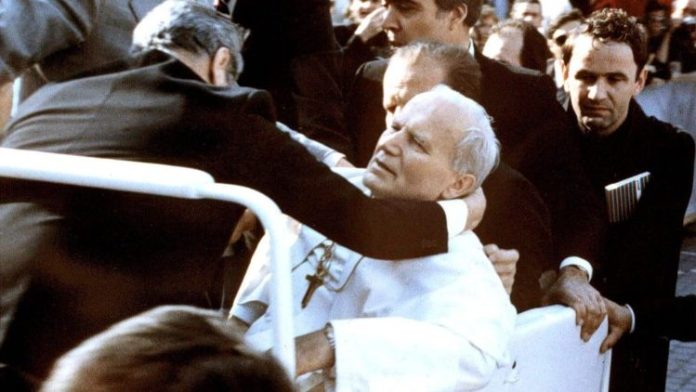by InTrieste
Forty-four years ago today, gunshots rang out in St. Peter’s Square, marking one of the most shocking moments in modern Vatican history. On May 13, 1981, Pope John Paul II was shot and gravely wounded during a public audience in front of thousands of stunned worshippers.
The attack, which took place as the pope rode through the square in an open vehicle, reverberated across the globe. As he waved to the faithful from the Popemobile, four gunshots were fired at close range. The pontiff collapsed into the arms of his aides as the vehicle sped toward safety, pursued by security officers.
John Paul II, then 60, was struck in the abdomen, left hand, and right arm. He was rushed to Rome’s Gemelli Hospital, where he underwent emergency surgery that lasted more than four hours. Doctors later described the procedure as successful, noting that no vital organs had been hit.
Two female bystanders were also injured in the attack.
The shooter, 23-year-old Turkish national Mehmet Ali Ağca, was apprehended at the scene. Italian authorities identified him as a fugitive and a far-right militant who had previously been convicted in Turkey for the 1979 assassination of journalist Abdi İpekçi. Ağca used a false passport to enter Italy, and police recovered the Browning handgun used in the attack.
The shooting was broadcast live by Vatican Radio, with journalist Benedetto Nardacci famously noting that “for the first time there is talk of terrorism even in the Vatican.”
In the days following the attack, the Vatican was flooded with messages of support. Pope John Paul II, from his hospital bed, addressed the faithful in a recorded message, offering forgiveness to his attacker and referring to him as “my brother.”
The pontiff made a full recovery and was released from the hospital less than a month later. On December 27, 1983, in a moment that drew international attention, he visited Ağca in Rebibbia prison, offering a personal gesture of reconciliation.
Ağca remained in Italian custody for nearly two decades before being pardoned in 2000 by President Carlo Azeglio Ciampi, at the pope’s request. He was deported to Turkey, where he served additional prison time before being released in 2010, five years after John Paul II’s death. The former pontiff was canonized in 2014.
To this day, questions remain about the motivations behind the attempted assassination. While Ağca claimed responsibility, conspiracy theories have lingered for decades. Some point to Cold War geopolitics, speculating about potential involvement by Eastern Bloc intelligence services, given John Paul II’s outspoken stance against communism.
In a 2021 interview with Italian news agency ANSA, Ağca, now living in Istanbul, remarked: “Certainly full light has not been shed on the attack on Pope John Paul II,” and observed that “many people’s memories are fading in a world full of events.”
Marking the 40th anniversary of the shooting in 2021, Pope Francis reflected on his predecessor’s belief that he had survived thanks to the intervention of the Virgin Mary, known in Catholic tradition as Our Lady of Fatima. “He was certain that he owed his life to Our Lady of Fatima,” Francis said. “This makes us aware that our lives and the history of the world are in God’s hands.”
The events of that spring day in 1981 remain a turning point in the papacy of John Paul II and a sobering reminder of the vulnerability of even the most revered figures.





























